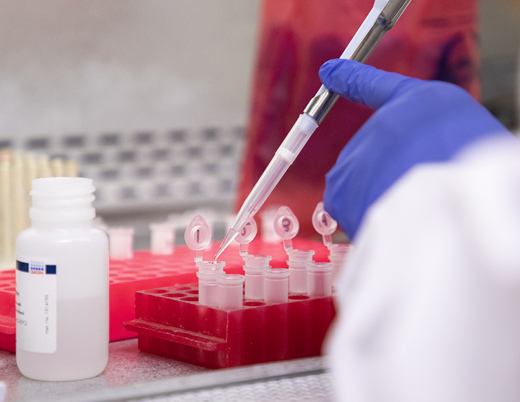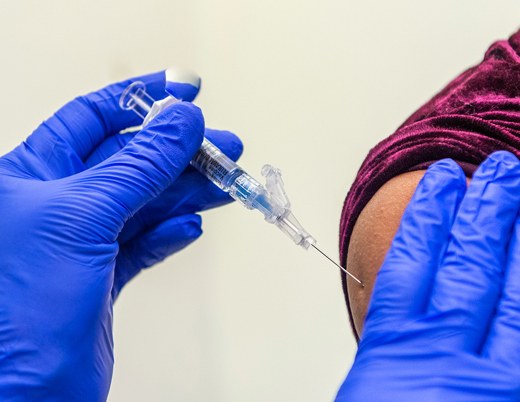How is data finally shedding some light on the elusive and debilitating condition known as long COVID?
For most of us, the novelties of a once-in-a-lifetime global pandemic have worn off. Many have tucked away their KN95 masks and rapid tests on a high-up shelf. Vaccines are becoming more routine, and teachers barely bat an eye when another student reports a case of COVID-19. Even the Centers for Disease Control and Prevention have downgraded the quarantine and isolation protocols for a virus that, until recently, held the entire world in its strong, deadly grip. But for some children, COVID-19 isn’t just a memory of two rough weeks last summer — it’s a persistent and unyielding daily reality. And for researchers at Children’s Hospital Colorado, it’s those people who define the next phase of COVID-19.
Search the internet for a definition of long COVID, and you likely will walk away confused. It could last weeks, months or years. It might just be an annoying cough that hangs around a little longer than expected, or it could be fatigue so debilitating it impacts school, work and life.
“Ever since the pandemic, there has been this subset of kids who were just not recovering as quickly as other individuals and that was manifesting in lots of different ways,” says Children’s Colorado infectious disease specialist Suchitra Rao, MD. “This is something that touches many of the providers who work at Children's Colorado. It manifests as respiratory conditions, as cardiac conditions, as GI complaints, as mental health conditions. It really is something that can affect any organ system. And so, there was a collective need to explore and study this more.”
“It’s a new entity, and there’s still so much that we need to understand and learn about long COVID, because even though it’s something that’s rare, it can prevent people from having a healthy existence.”
-Suchitra Rao, MD
Becoming part of RECOVER
That’s the impetus behind a National Institutes of Health-led research initiative known as RECOVER: Researching COVID to Enhance Recovery. The project has many branches, poking and prodding long COVID from every angle to uncover new information, treatments and leads. For three years, Children’s Colorado researchers have contributed to the pediatric electronic health records cohort of the project through an affiliation with electronic health record network PEDSnet, which receives funding from RECOVER.
Dr. Rao serves as one of the principal investigators for the RECOVER pediatric electronic health record cohort and is the site principal investigator for PEDSnet at Children’s Colorado, coordinating and facilitating several new projects each year that help build a deeper understanding of how long COVID functions in children. This branch of the RECOVER research initiative involves careful examination of multiple data sources, including everything from clinical data and laboratory data to vital sign and digital health data. And with data from 8.9 million patient records, their findings hold significant weight.
“We were able to start collecting information on patients who were undergoing testing for SARS-CoV-2,” Dr. Rao says. “Then we could start learning about what these patients with long COVID were going on to develop — which kids were getting better, which ones were having persistent symptoms, which ones were having ongoing healthcare needs. And so, we've developed a number of studies to answer different questions around long COVID.”
In addition to the electronic health record work, Dr. Rao also is part of another branch of the RECOVER project called MUSIC, which is investigating a rare complication of COVID called multisystem inflammatory syndrome in children, or MIS-C. As part of this, she’s following children who have been diagnosed with MIS-C to monitor and report on their recovery, noting any additional long-term issues that arise.
Characterizing long COVID symptoms
In the first two years of its work with the RECOVER initiative, the Children’s Colorado team published 10 papers, with more on the way. One of these studies, published in JAMA Pediatrics, took great strides in characterizing the ways in which long COVID presents in the pediatric population.
The study (1) considered records from 659,286 children tested for SARS-CoV-2 between March 1, 2020, and Oct. 31, 2021. Of those children, roughly 60,000 tested positive for the virus. The team compiled health data for each child for the six months following their test and compared those who had COVID to those who did not. Investigators found that 41.9% of kids who tested positive for SARS-CoV-2 displayed some symptom or condition that can be associated with long COVID, compared to 38.2% of kids who tested negative. This nearly 4% difference indicates that long COVID is indeed a concern among children, says Dr. Rao, who was first author on the manuscript.
“This was a very large cohort, and it showed that long COVID is manifesting in kids and that there are some flavors of it that seem a little bit different to what was being seen in adults,” she explains.
Not only did the study show that kids are experiencing long COVID, but it also helped researchers gain an understanding of what that might look like. Some of the most common conditions found in these children included acute respiratory distress, myositis, mental health concerns, teeth and gum disorders, and myocarditis. Researchers also found patterns in symptoms not associated with a secondary condition, such as changes in taste and smell, hair loss, chest pain, generalized pain and abnormal liver enzymes.
What’s more, the study helped identify which kids might be most at risk for long COVID. Among the children studied, those who experienced more severe acute COVID illness or who had chronic, complex conditions were at a higher risk of developing long COVID.
The team followed up this study with one that used machine learning to further characterize long COVID and provide a tool for defining and classifying it (2). The wide variety of symptoms and conditions that can manifest as part of long COVID have created a gap in providers’ ability to predict which kids might end up with long COVID and to diagnose long COVID when they see it. This, in turn, impacts patient enrollment in pediatric clinical trials and studies, as official long COVID diagnoses in children have been scarce.
The study used a tree-based scan statistic data mining tool to identify diagnoses, medications, procedures and diagnostic test codes that were disproportionately seen in patients with long COVID. Results from the study validated the power of this tool in identifying kids with long COVID — something that is particularly important in a pediatric setting, in which long COVID is underdiagnosed due to its tendency to present as milder than it does in adults.
Vaccine effectiveness
Most recently, the team published a study (3) that has made headlines for its insights on the efficacy of COVID vaccines. By gathering data from 17 different health systems, investigators determined just how invaluable COVID-19 vaccines are for the pediatric population.
This work necessitated a cohesive understanding of a condition notorious for its difficulty to pin down. By using a definition for long COVID developed based on all its previously published research, the team was able to focus in on a pool of patients with long COVID and cross-check their records for vaccination status.
“If you look at all of the data, you’ll see that the vaccine’s effectiveness against long COVID was 35% to 42%,” Dr. Rao explains. “The vaccine’s effectiveness was higher in adolescents than in younger kids, and the effects were stronger within that six-month timeframe of receiving the vaccine. So, it was actually 61% effective within six months, but then it did decrease.”
These findings have the potential to move minds among providers and caregivers alike, because not only do they show conclusive evidence regarding the value of using vaccines against long COVID, but they also come from the largest national-scale study on vaccine effectiveness in pediatrics to date, with a cohort of more than a million children.
“During a time when people might be questioning whether to give their children boosters or their adolescents the vaccine, this is good evidence that it would have an impact.”
-Suchitra Rao, MD
“The main message was that vaccination can be helpful in not just minimizing severe COVID, but also in the prevention of long COVID,” Dr. Rao says. “During a time when people might be questioning whether to give their children boosters or their adolescents the vaccine, this is good evidence that it would have an impact.”
With each new study, the Children’s Colorado RECOVER team has wielded data as the ultimate tool to explain the unexplainable, measure the intangible and lift the fog shrouding long COVID. In doing so, these researchers have helped construct a path for every child and family facing a scary, lingering and uncertain future as a result of this disease.
“A lot of kids are not able to go to school. A lot of adults are not able to continue their work. It's now turning into this very prominent chronic disease,” Dr. Rao says. “It’s a new entity, and there’s still so much that we need to understand and learn about long COVID because even though it’s something that’s rare, it can prevent people from having a healthy existence.”
Citations
- Rao, Suchitra et al. “Clinical Features and Burden of Postacute Sequelae of SARS-CoV-2 Infection in Children and Adolescents.” JAMA pediatrics vol. 176,10 (2022): 1000-1009. doi:10.1001/jamapediatrics.2022.2800.
- Lorman, Vitaly et al. “A Machine Learning-Based Phenotype for Long COVID in Children: An EHR-Based Study From the RECOVER Program.” PloS one vol. 18,8 e0289774. 10 Aug. 2023, doi:10.1371/journal.pone.0289774.
- Razzaghi, Hanieh et al. “Vaccine Effectiveness Against Long COVID in Children.” Pediatrics, 10.1542/peds.2023-064446. 16 Jan. 2024, doi:10.1542/ peds.2023-064446.
Featured researcher

Suchitra Rao, MBBS, MSCS
Pediatric infectious disease specialist
Pediatric Hospitalist Services
Children's Hospital Colorado
Associate professor
Pediatrics-Pediatric Hospital Medicine
University of Colorado School of Medicine





 720-777-0123
720-777-0123










